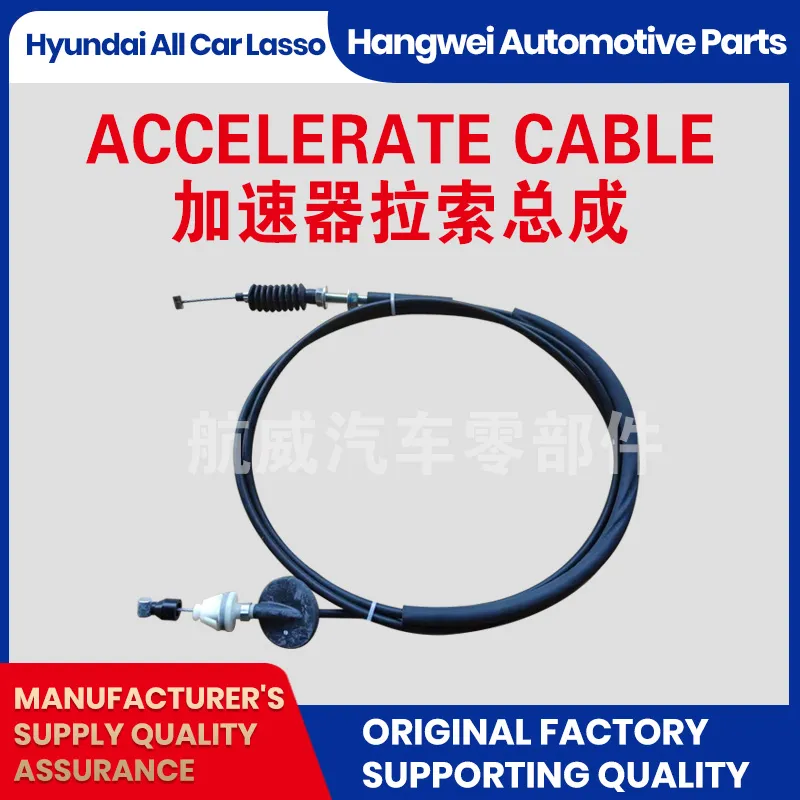Throttle Cable: Durable, Smooth, Universal Fit & Adjustable
Accelerator Push-Pull Cable: field notes, specs, and what buyers actually ask
When people say Throttle Cable, they usually mean a Bowden-style push-pull assembly with precise returnability. In our sector, it’s the quiet hero that translates pedal intent into engine response. This Accelerator Push-Pull Cable—made in Qinghe County Minjiang Street south, Wuzhishan Road east—has been showing up in OEM bids more often lately. Why? Reliability under ugly routing and tight dashboards. Honestly, that’s where many lower-cost imports stumble.

What it is (and where it fits)
The accelerator cable assembly transmits pedal motion to the engine control or throttle body. Applications include passenger vehicles, motorcycles, small engines, forklifts, marine throttles, generators, off-highway equipment, and—surprisingly often—retrofitted motorsport builds where drive-by-wire isn’t desired.
Customers tell us they pick this Throttle Cable when they need predictable actuation force over long routes, low stick-slip, and compliance with returnability rules.
Product specifications (typical)
| Parameter | Spec (typ.) | Notes |
|---|---|---|
| Core wire | SUS304, 1×19 strand | Low stretch, good corrosion resistance |
| Core diameter | ≈ 1.2–2.5 mm | Depends on load and stroke |
| Conduit | Steel spiral with HDPE/PTFE liner | Low friction liner; options PA11 sheath |
| Stroke travel | Up to ≈ 120 mm | Longer by customization |
| Min bend radius | ≈ 75 mm | Real-world use may vary |
| Tensile capacity | ≈ 1.5–2.8 kN | By diameter and fittings |
| Operating temp. | −40 to 120 °C | Higher with PTFE liner |
| End fittings | Ball, clevis, bulkhead M6/M8 | Custom swaged ends available |
| Service life | ≥ 300k cycles | Tested at ambient; see data below |
| Compliance | IATF 16949, ISO 9001, RoHS/REACH | Plant certifications |
Process flow, materials, and testing
Materials: SUS304 stranded core; galvanized steel conduit; HDPE or PTFE liner; PA11/PVC outer sheath; zinc-nickel plated fittings. Methods: multi-die wire drawing, stranding, swaging, crimping with calibrated presses, liner pre-lube (PTFE-based), 100% visual and pull-test on assemblies.
Testing: returnability vs. FMVSS 124; salt-spray per ASTM B117 (96–240 h options); temperature cycling per ISO 16750 (−40/120 °C); vibration per ISO 16750-3; life-cycle rigs at 60 cpm to 450k+ cycles; friction force trend logging. Typical internal results: actuation force at 500 mm route ≈ 18–28 N new, drift ≤ +15% after 300k cycles; coefficient of friction μ ≈ 0.08–0.12; no red rust to 120 h on plated ends.
Where it’s used (and why it wins)
- Passenger cars, LCVs, motorcycles: stable pedal feel, low hysteresis.
- Forklifts, ag & construction: tolerant of tight bends; rugged sheath.
- Marine & gensets: corrosion-minded materials; sealed boots optional.
Advantages many customers mention: quieter operation after break-in, fewer routing complaints, and fewer returns versus “no-name” imports. To be honest, the liner quality makes or breaks a Throttle Cable.
Customization options
Cut-to-length conduit, bespoke strokes, firewall/bulkhead hardware, low-temp grease, high-heat PTFE liner, color sheaths, serialized labels, PPAP documentation. Origin labeling per customer program.
Vendor snapshot (indicative)
| Vendor | Customization | Lead time | Certs | Life (typ.) | Price |
|---|---|---|---|---|---|
| HWEI (this product) | Extensive | ≈ 2–4 wks | IATF 16949, ISO 9001 | 300k–1M cycles | Mid |
| Imported Brand A | Limited | ≈ 6–10 wks | ISO 9001 | 150k–300k | High |
| Trading House B | Variable | ≈ 3–6 wks | Mixed | 100k–250k | Low |
Note: comparative data reflects public info and buyer feedback; real-world results vary by routing and environment.
Quick case study
A Tier-2 forklift OEM reported intermittent sticking in humid coastal depots. After switching to a PTFE-lined Throttle Cable with a larger bend radius spec and zinc-nickel fittings, actuation force dropped ≈22%, and throttle-related warranty returns fell 68% over nine months. Not flashy, just solid engineering.
Standards and certifications checklist
- FMVSS 124 returnability compliance (design validation)
- IATF 16949:2016, ISO 9001:2015 quality systems
- Environmental tests to ISO 16750; corrosion to ASTM B117
- Materials compliant with EU RoHS and REACH
- Design guidance referencing DIN 71986 (Bowden cables)
If you’re speccing for a new platform, my two cents: lock routing early, keep bend radii generous, and request life data at your worst-case path. It seems obvious—until a late bracket change turns a smooth Throttle Cable into a warranty headache.
Authoritative citations
- FMVSS No. 124 — Accelerator Control Systems, U.S. NHTSA
- IATF 16949:2016 — Automotive Quality Management System, IATF
- ISO 16750 — Road vehicles — Environmental conditions and testing
- ASTM B117 — Standard Practice for Operating Salt Spray (Fog) Apparatus
- DIN 71986 — Bowden cables: requirements, testing, and design guidance
-
Clutch Line: Braided, Leak-Proof, OEM-Grade PerformanceNewsNov.10,2025
-
Throttle Cable: Durable, Smooth Control & Universal FitNewsNov.10,2025
-
Throttle Cable: Durable, Smooth, Universal Fit, Easy InstallNewsNov.10,2025
-
Clutch Line: Durable, Leak-Proof, OEM-Grade PerformanceNewsNov.10,2025
-
Hand Brake Cable | Custom, Universal & Trailer SolutionsNewsNov.10,2025
-
Clutch Line: High-Pressure, OEM-Fit, Corrosion-ResistantNewsNov.03,2025
